For years, Malaysia cruised under the tourist radar, overshadowed by its more popular Southeast Asia neighbors such as Thailand and Singapore.
Yet, steady economic growth and a particularly catchy “Malaysia Truly Asia” tourism campaign have helped lift the country to prominence.
Malaysia is a tapestry of diverse cultural influences, drawing from its local indigenous, Malay, Indian and Chinese communities as well as its colonial heritage.
It’s also a story of contrasts – a place where smooth highways lead to both modern cities and lush rainforests, where street vendors set up shop in the shadows of skyscrapers and hipster cafes operate next to traditional kopitiams (coffee houses).
On August 31, Malaysia celebrates Merdeka Day, signifying 60 years of independence from British rule.
In commemoration, we’ve compiled a list of 25 things to do and eat in this unmissable Southeast Asia destination.
THINGS TO DO
1. Discover Malaysian wildlife
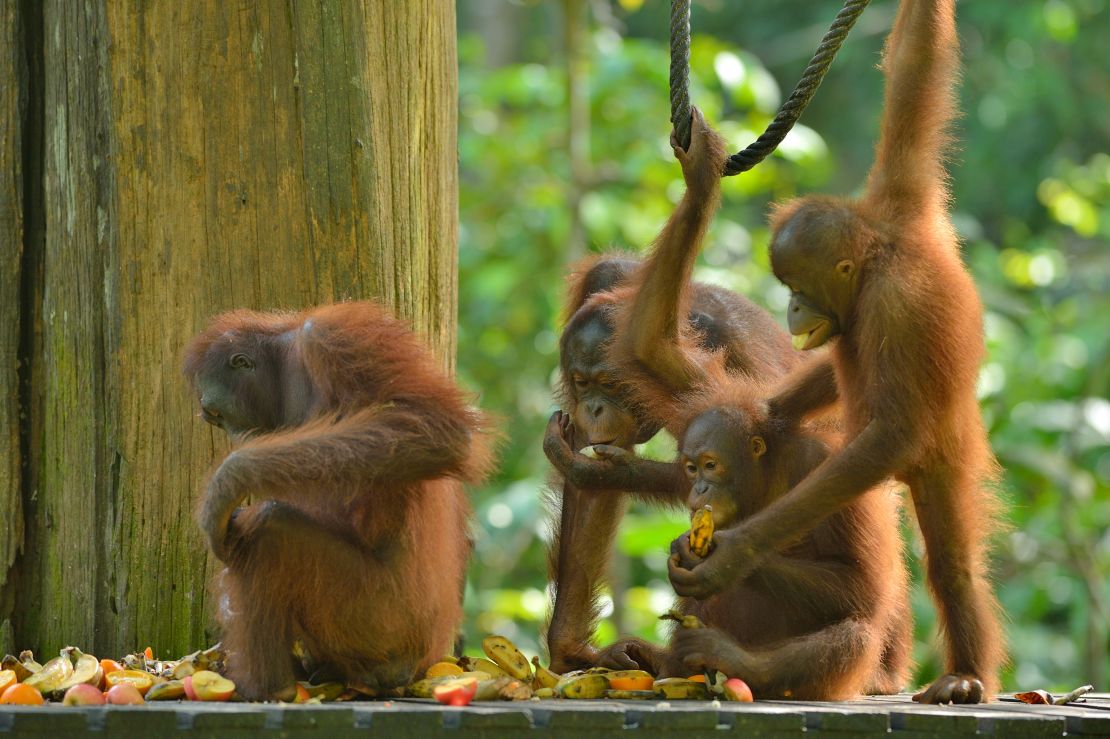
Malaysia has no shortage of natural beauty – it’s home to one of world’s oldest rainforests, extensive cave systems and immense mangrove forests.
Naturally, this makes the nation an ideal destination for wildlife spotting.
Travelers can observe fauna overnight from the safety of huts inside Pahang National Park, where the oldest deciduous rainforest in the world awaits.
In Kuala Gandah – also in the state of Pahang – guests can accompany orphaned elephants for daily baths at the National Elephant Conservation Centre.
Meanwhile, the Sepilok Orangutan Rehabilitation Centre in Sabah on the island of Borneo offers a glimpse of these endangered great primates in their natural environment. They tend to swing by the viewing platform around feeding times, at 10 a.m. and 3 p.m.
Next door, the Bornean Sun Bear Conservation Centre is dedicated to the world’s smallest bear species.
2. Stay in a village
The Malaysian Homestay program works with local communities to offer an authentic kampung (village) experience.
Curious travelers can stay with local hosts – or in traditional long houses – both in Peninsular Malaysia and Sabah and Sarawak in the east.
The experience includes daily village activities, such as preparing local meals, fishing, feeding livestock or learning Malaysian games such as congkak (a wooden board game) and gasing (spinning tops).
3. Explore Gunung Mulu National Park
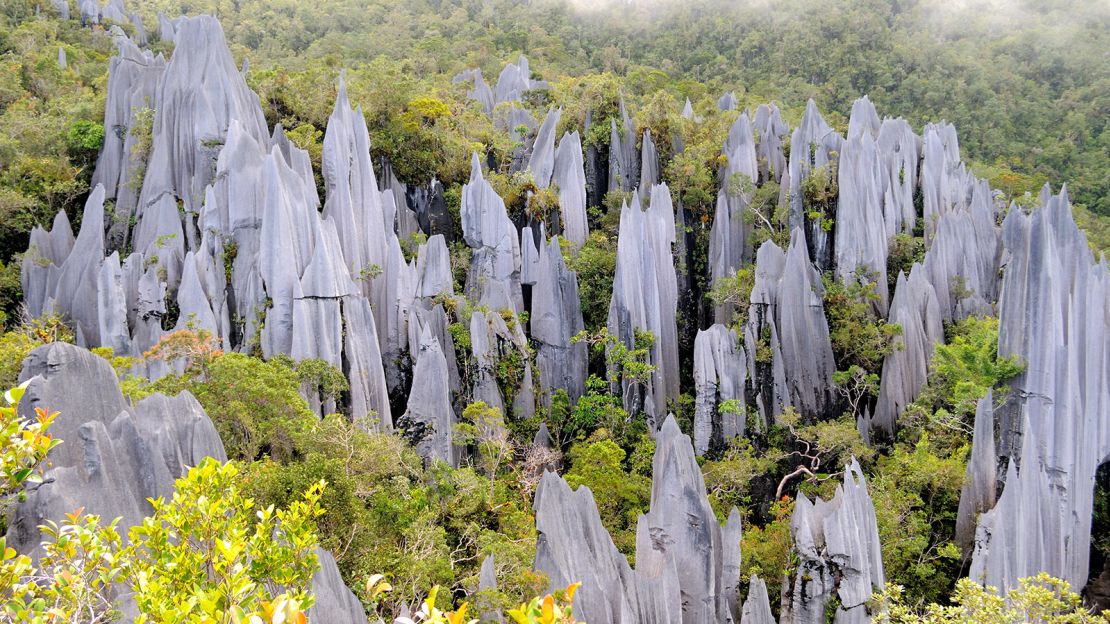
A UNESCO World Heritage Site, Gunung Mulu National Park in Sarawak is famous for its millennia-old karst cliffs.
For keen spelunkers and climbers, this means challenging mountain faces to scramble up and explore jaw-dropping cave chambers.
Deer Cave, for example, forms the largest cave passage in the world, measuring 400-550 feet in diameter. Located to the northeast of Deer Cave, Sarawak Chamber is the world’s largest cave chamber, stretching about 2,000 feet in length, 1,400 feet wide and almost 33 feet high.
But not just anyone can jump in: Visitors keen to explore the more advanced cave systems must provide certification or proof of ability for the park manager’s approval.
4. Go whitewater rafting
Adrenaline addicts will appreciate Malaysia’s intricate network of rivers, which offers rapids for all levels of difficulty.
For class 1-4 rapids the Selangor River in the town of Kuala Kubu Bharu in Selangor, Slim River in Perak and Padas River in Sabah are just a few of the many popular destinations for recreational whitewater rafting.
More experienced rafters can head to the Telom River in Pahang to tackle class 5 rapids.
And if that’s not enough, Singoh River in Perak is where rapids reach a heart-stopping level 6 – the highest level on the international rapid scale, only to be attempted by experts.
5. Hunt for fireflies
Your boat is gliding silently along a mangrove-lined river. Daylight is waning and suddenly, you spy hundreds of flickering lights.
In Malaysia, there’s only one thing it could be: Fireflies.
Also known also as lightning bugs, or kelip-kelip in the local Malay language, these tiny creatures are beloved for their beauty.
There are several locations where travelers can admire the flickering insects, including Kuala Selangor in Selangor; Kuala Sepetang in Perak, Kampung Cherating in Pahang, Kuching in Sarawak as well as Sandakan, Semporna and Kota Kinabalu in Sabah.
As a bonus, some tour groups will even throw in a seafood dinner before or after the boat ride.
6. Find an island paradise
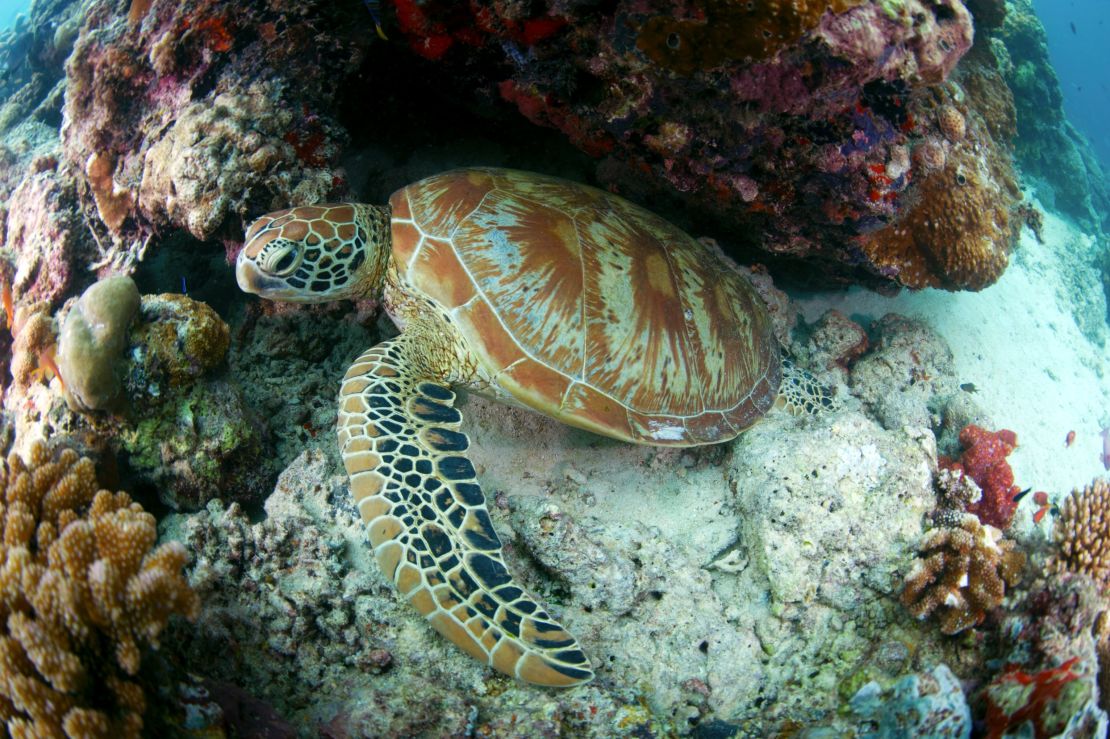
If it’s clear water and sandy shores you’re after, Malaysia’s got you covered.
From luxury resorts to private islands, backpacker hostels and beachfront bungalows, there’s an island experience for every budget.
Not to mention a few of the world’s best dive sites.
The rich waters are teeming with sea creatures, such as hammerhead and other sharks, barracudas, sea turtles and manta rays.
For diving, popular choices include the Perhentian Islands, Redang Island in Terengganu, Tioman Island in Pahang, Pangkor Island in Perak, Langkawi Island in Kedah, and Gaya, Sipadan and man-made Layang-Layang island, all off Sabah.
Plan ahead as islands off the east coast are closed from October to February or March, due to the annual monsoon season.
7. Try metalworking
At its height in the 19th century, Malaysia was the largest provider of tin ore in the world. And where there’s tin, you will find pewter, a gray alloy metal made up of tin, copper and antimony.
Royal Selangor, the world’s largest pewterware producer, gives travelers a hands-on introduction.
Opened in 1885, the historic brand’s headquarters offers two pewtersmithing workshops: the School of Hard Knocks for beginners and the more challenging The Foundry.
Under the guidance of a trained pewtersmiths, travelers use traditional tools and techniques to create their own keepsakes.
Royal Selangor, Visitor Center 4, Jalan Usahawan 6, Setapak Jaya, Kuala Lumpur, Malaysia; +60 3 4145 6122
8. ‘Backpack’ on two wheels
The cycling community in Malaysia has grown dramatically in recent years thanks to emerging networks of cycling lanes in cities across the country, such as Kuala Lumpur, Shah Alam in Selangor, George Town in Penang and Putrajaya, Malaysia’s administrative capital.
Many experienced cyclists, too, are abandoning urban paths and taking to dirt roads to better explore the country.
One cycling enthusiast, Nadiah Aziz – who blogs about her cycling adventures at Folding Tales – describes cycling as “the new way to backpack.”
And you won’t have to go it alone: Many grassroots groups organize cycling excursions along lesser-frequented trails.
Among them are Cycling Kuala Lumpur, Bicycle Map Project (KL), husband-wife mountain biking team Doowaroda (nation-wide), and Kinabalu Iron Horse (Sabah).
9. Tour the region’s largest Islamic Arts Museum
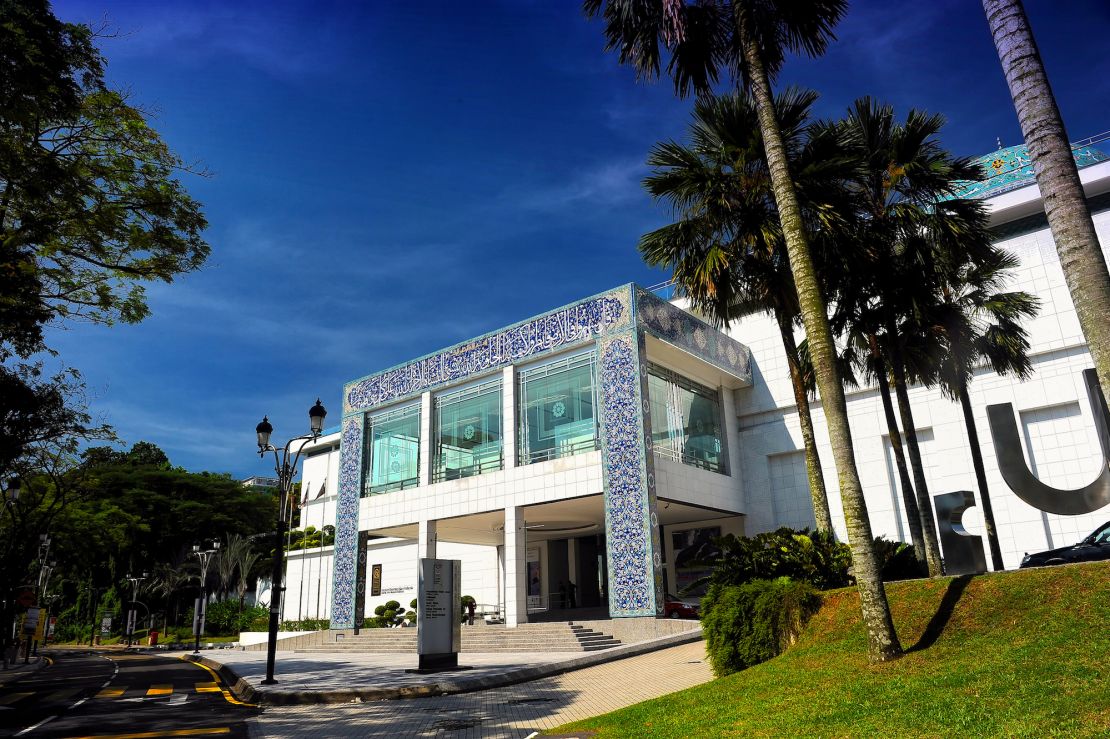
The largest museum of its kind in Southeast Asia, the Islamic Arts Museum Malaysia showcases the richness of Islamic cultures through its extensive collections of artworks and artifacts.
The museum emphasizes works from Asia – specifically, China, India and the Malay Archipelago.
It offers a sense of Malaysia’s unique form of Islamic identity, a result of its location at the center of once great trade routes, Islam’s simultaneous expansion in the region and the country’s eventual multicultural makeup.
Islamic Arts Museum Malaysia, Jalan Lembah Perdana, Kuala Lumpur, Malaysia; +60 3 2092 7070
10. Learn about Malaysia’s musical history
Opened last year, the Penang House of Music, an interactive history museum, tells the story of the island’s musical heritage.
This large complex chronicles Malaysia’s musical beginnings, achievements and musical greats, such as famed singer-songwriter, director, and actor P. Ramlee, jazz legend Jimmy Boyle and composer Ahmad Nawab.
The House of Music also documents local traditional art forms such as bangsawan, boria, ronggeng, puppet theater and Chinese opera.
Those harboring secret hopes of becoming a radio DJ can give it a try in the Radio Room.
Penang House of Music, L4-02, 4/F, KOMTAR, Penang, Malaysia; +60 4 370 6675
11. Tour one of the world’s newest capitals
Putrajaya from above: Ballooning over Malaysia's most architecturally stunning city
Gleaming and manicured, Putrajaya is the new kid on the block.
As per the vision of Malaysia’s fourth and longest-serving Prime Minister, Dr. Mahathir Mohamad, Putrajaya has been the nation’s administrative capital since 1997.
It’s a purpose-built city and a must-see for architecture buffs. Buildings and structures here make up an eclectic blend of modern aesthetics, traditional Moorish or Islamic influences, and even Palladian or Neoclassical touches.
Most notable is the dramatic Palace of Justice, the iconic rose-pink Putra Mosque atop Putrajaya Lake, and the contemporary curves of the Seri Wawasan bridge.
You can also opt for a bird’s eye view, as hot air balloon rides are available. More on the experience here: Putrajaya from above.
12. Hit the streets of Kuala Lumpur
Much more than just the country’s capital, commercial and entertainment hub, Kuala Lumpur is Malaysia’s beating heart.
The 88-story Petronas Twin Towers – the world’s tallest twin buildings – punctuates almost every view of the federal territory’s skyline.
A ride up to the Skybridge, which connects the two towers, ensures a stunning city view.
For a peek into KL’s diverse history, a visit to Little India – known as Brickfields – promises color at every turn, with temples and traders, flower garlands, Indian clothing stores and delectable South Indian sweets, snacks and hot meals.
Meanwhile, in KL’s Chinatown on Petaling Street, travelers can try their luck haggling with street vendors, who sell everything from watches, perfumes and designer bags to luggage.
13. Experience Malaysia’s religious beauty
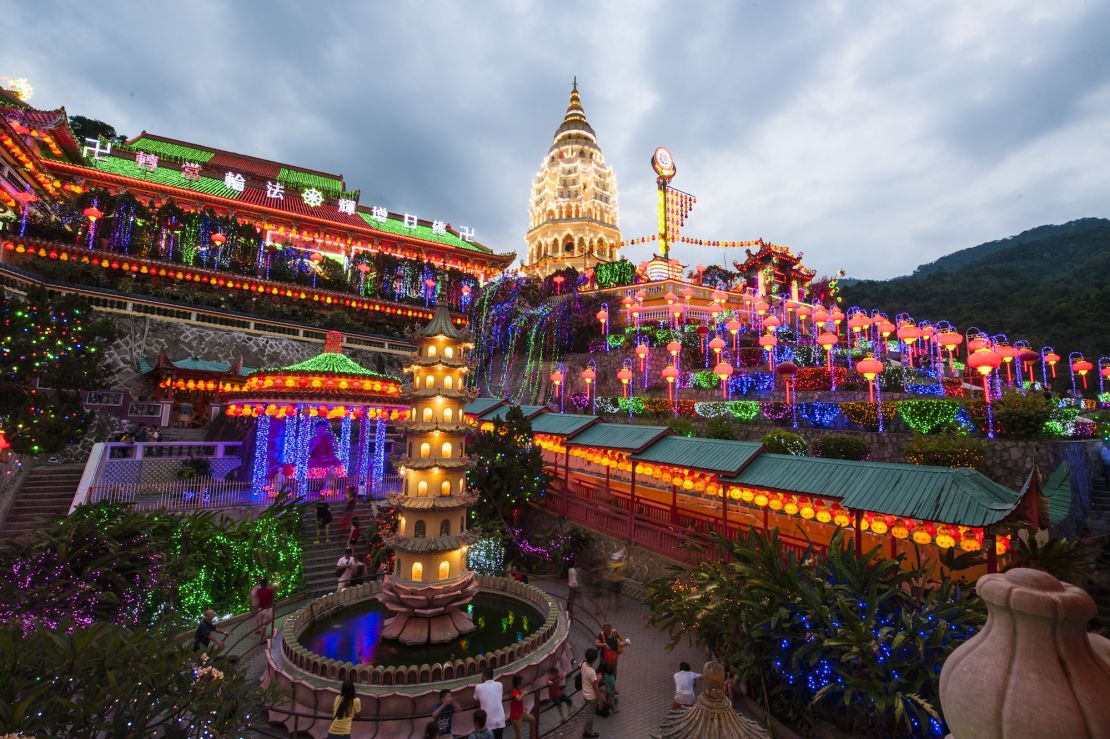
With a rich immigrant and colonial history, Malaysia is truly rojak – a term that literally refers to a local fruit salad, but has come to describe the country’s diverse mix of cultures and religions.
This is reflected in the sheer number places of worship, from Moorish Malay-influenced mosques to South Indian-inspired Hindu temples and Chinese Taoist temples.
Most allow visitors, but it’s important to take heed of timing, dressing regulations and prayer times.
Which ones to visit?
Situated at the confluence of the Klang and Gombak rivers, red-bricked Masjid Jamek (or Jamek Mosque) is an incredibly beautiful building with deep historical significance.
With its lovely white arches and domes, it’s at the muddy confluence where KL was born, and gets its name from.
Meanwhile, Penang’s Kek Lok Si – founded over a century ago – has grown into a huge complex of temples and is a major draw for Buddhists across Southeast Asia.
Striking in size and design, the complex merges Chinese and Buddhist influences and is renowned for its impressive collection of Buddhists statues, paintings and carvings, a seven-story pagoda and 100-foot-tall Goddess of Mercy statue.
One of Malaysia’s most iconic sites, Batu Caves refers to large Hindu limestone cave temples located in the state of Selangor, just north of Kuala Lumpur.
While some estimate the caves to be millions of years old, the shrines within are about 130 years old. Marked by a giant 140-feet-high statue of Lord Muruga out front, pilgrims have to climb 272 steep stairs to reach the vast main Temple Cave.
And finally, St. Mary’s is a late 19th-century cathedral located next to KL’s famous Dataran Merdeka, or Independence Square.
Its elegant white early-English Gothic architecture is definitely eye-catching, as is the church’s 110-year old ‘Father Willis’ pipe organ.
14. Enjoy some live music
Jazz lovers have a couple of options as Malaysia hosts both the internationally acclaimed Borneo Jazz Festival in Sarawak and the Penang Island Jazz Festival, Malaysia’s longest-running jazz festival.
Those dancing to a different beat can make their way to Sarawak, for the annual Rainforest World Music Festival.
Every July, a mix of international and indigenous musicians gather for three nights of music, dancing and fun at the beautiful Sarawak Cultural Village – with the stunning Mount Santubong as a backdrop.
15. Visit historic Malacca City
The capital of the coastal state of Malacca (also spelt Melaka), Malacca City is known for its delicious food and picturesque streets – lined with old shop houses and antique dealers.
Named a UNESCO World Heritage site, the city has retained much of its Portuguese and Dutch colonial influences, as well as its Malay and Peranakan heritage.
Also called Baba-Nyonya (Baba for male and Nyonya for female), the Peranakan people are descendants of Chinese migrants who, after arriving in the Malay Archipelago, eventually married local women and assimilated with the latter’s customs, creating their own sub-culture and cuisine.
The beautiful Baba and Nyonya Heritage Museum (No. 48 & 50 Jalan Tun Tan Cheng Lock, Malacca; +606-282 1273) offers great insights into this history.
Meanwhile, the iconic red Dutch Stadthuys Complex and nearby centuries-old A’Famosa Fort give travelers a sense of the area’s colonial past – not to mention plenty of Instagram material.
In the evening, Jonker Walk, in Malacca’s Chinatown, comes alive as traders set up stalls selling everything from souvenirs and clothes to snacks and antiques.
Been to Malacca and looking for another destination with a rich architectural, cultural and culinary heritage? Check out Ipoh, which is going through a tourism revival.
16. Hunt for the world’s largest flower
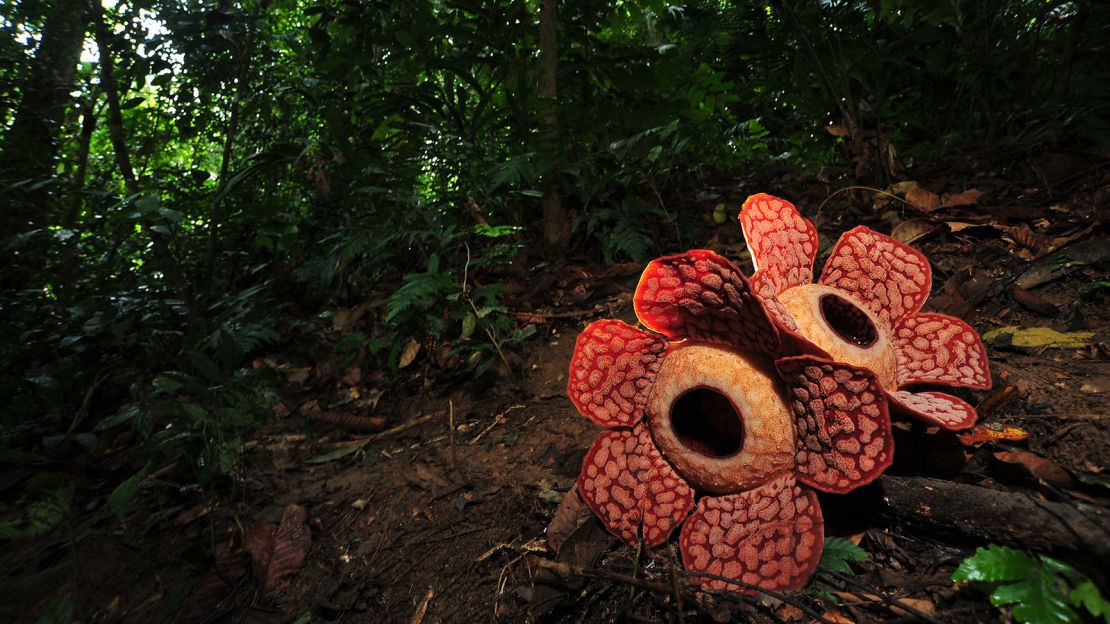
The parasitic Rafflesia flower has the world’s largest bloom – and it’s found only in Southeast Asia.
With no leaves, no stems and no proper roots, these giants grow deep in the jungle. They’re a sight to behold – their deep red petals can measure up to an inch thick and exceed three feet in diameter.
Once bloomed, Rafflesias remain open for just few days so seeing one is a rare treat. Guided tours through amazing Malaysian forest reserves take travelers in search of these marvels. To avoid disappointment, check before booking to make sure they’re in bloom.
Where to see them? Royal Belum Forest Reserve in Perak, Gunung Gading National Park in Sarawak and Tambunan Rafflesia Information Centre in Sabah.
WHAT TO EAT
17. Milo
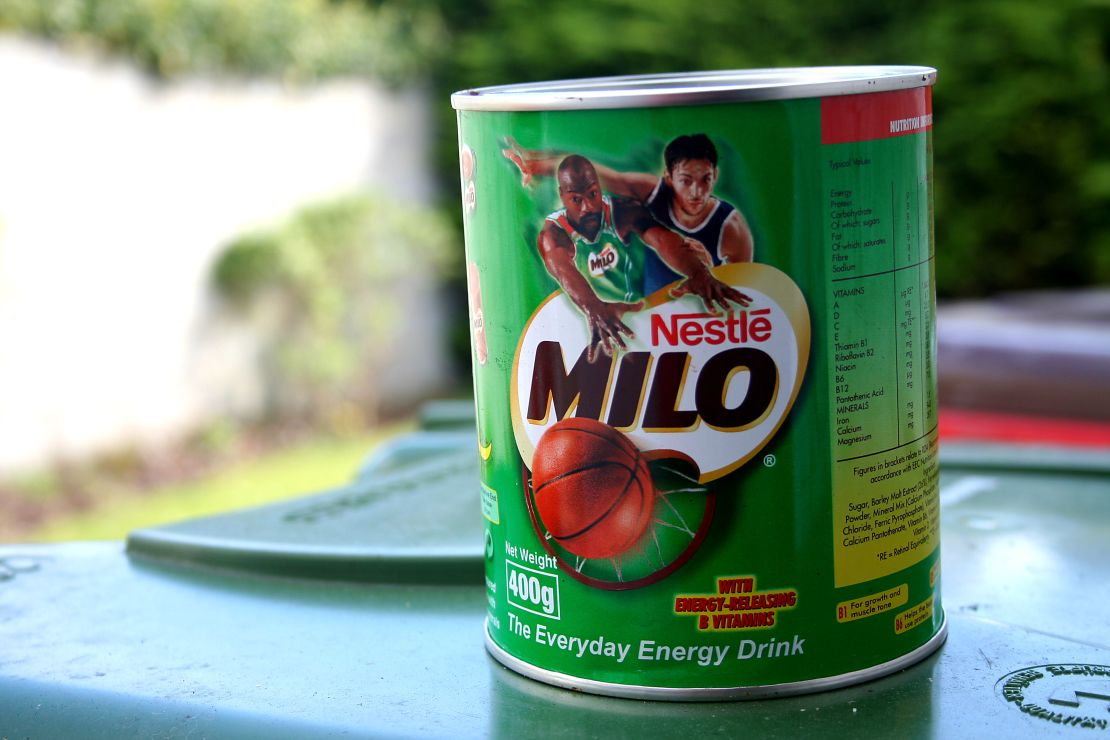
Ask any Malaysian who grew up in the 1980s for a fond childhood memory and you’re bound to hear at least one involving the bright green Milo truck, where kids would line up for a cup of chilled iced chocolate.
And it’s not just for children. You can order a cup of Milo at Malaysia’s Indian-Muslim eateries, known as mamak shops, found throughout the country.
Such is the nation’s love affair with the chocolate malt drink that there are many versions of it – ask for the classic Milo Ice or hot Milo for a delicious, send-your-sugar-through-the-roof Milo and condensed milk hit.
Milo Dinosaur comes with a mountain of pure undissolved Milo powder on top, while mocha lovers will find “Neslo” a good alternative.
Not thirsty? Opt for Roti Milo for dessert: a classic indian flaky flatbread with Milo sprinkled liberally throughout.
18. ‘Ramly’ Burger
Malaysia’s answer to a Sloppy Joe, the “Ramly Burger” is hot, oozy, buttery, soft and incredibly messy to eat but tastes so, so good.
Popularized by roadside stalls offering the original Ramly brand beef patties, it has since become a general term for all stalls offering the simple yet delicious burgers – patties on grilled, buttered buns with condiments such as onions and cucumber, cheese, mayonnaise and the special, sweet chili sauce.
Just follow your nose towards the source of sizzling fat and toasting butter and keep an ear out for the steady hum of the generator.
19. Chili pan mee
Chili pan mee is a seemingly simple Malaysian Hakka dish but, like most of the country’s dishes, packs a punch of flavor.
Thick flat or hand-torn noodles are served dry in a bowl with a soft-poached egg, fried anchovies and minced pork, alongside a jar filled with a deceptively innocent-looking dried chili paste. You add as much, or as little of the paste to your bowl and give it a good stir.
Be warned, a little chilli paste goes a long, long way.
MORE: Cheap, cheerful and delicious: Kuala Lumpur’s best local eats
20. Claypot chicken rice
You can find this hot, satisfying meal in almost any non-halal hawker food court in the country, but claypot chicken rice is the specialty of the town of Kampar in the northern peninsular state of Perak.
Rice and chicken are cooked in a sticky, sweet dark sauce in claypots over charcoal fire, until they become beautifully caramelized and imbued with just the right amount of smoky flavor.
What makes or breaks this dish is the crispy rice crust that forms at the bottom of the pot. Think paella, but with Asian flavors.
21. Appam/Apam
Indian-style appam consist of crepes made from fermented ground rice and coconut milk. They feature crisp paper-thin turned-up edges, and a raised spongy center.
It’s served with sweetened coconut milk and sometimes even melted palm sugar. The more indulgent ones don a golden runny egg in the center.
And there’s also apam balik/ apom balik. Although similar to appam, it’s a completely different dish that some say originated in China.
It features chopped peanuts, sugar, loads of butter and creamed corn, all sandwiched between two thick, soft pancakes or encased within a folded crunchy crepe.
Whichever style you choose, they’re all best eaten hot and fresh out of the pan.
22. Manok pansoh
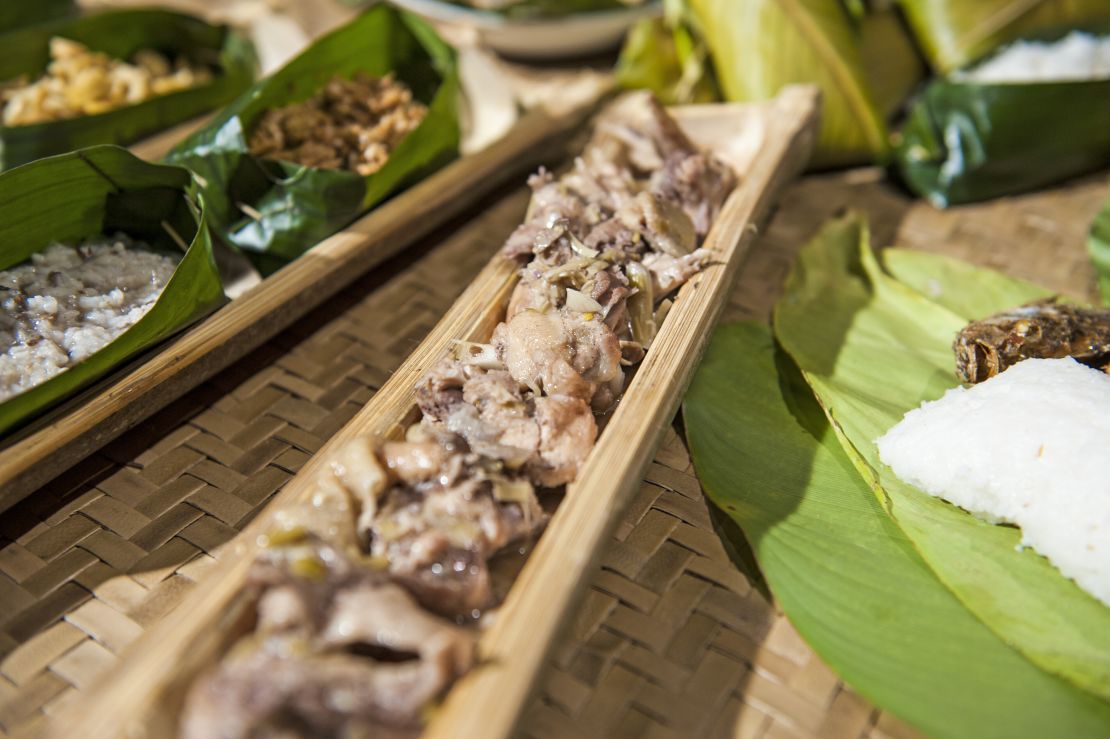
This is a traditional dish of the Iban and Bidayuh people of Sarawak. It’s prepared by slow-cooking chicken inside a long piece of bamboo over hot coals or wood fire.
The chicken is first marinated generously with lemongrass, tapioca leaves and ginger, among others, before being being stuffed inside the bamboo, and cooked.
The moist, fragrant meat is removed from the bamboo and served with rice.
Once only served during special celebrations or festivals, it’s becoming more readily available in throughout the state now.
23. Hinava
The Hinava fish salad, a delicacy of the Kadazan-Dusun people in Sabah, is similar to South American ceviche, but prepared Bornean style.
In it, pieces of fresh, raw fish are cured in lime, onion, chilli, salt and ginger. The resulting dish is light and delicate but with full on flavor.
Some versions feature the grated seed of a local fruit known as bambangan. In neighboring Sarawak, there’s a similar dish belonging to the Melanau people known as Umai, made with a local sour palm fruit known as kelubi or assam paya.
24. Kapitan chicken
If you travel to the coastal states of Malacca and Penang, you’ll come across the famed cuisine prepared by the Peranakan, or Baba-Nyonya, community noted for its bold, tangy and spicy flavors.
Among the highlights is Kapitan Chicken.
Getting its name from the term ‘Kapitan’ or Captain – used to refer to Chinese chefs appointed during colonial rule – the dish is a thick, aromatic curry made with a spicy blend incorporating, among others, belacan (shrimp paste), candlenut, lemongrass, kaffir lime leaves and galangal.
25. Kaya toast
Kaya means “rich” in the Malay language and kaya jam certainly is that. Sweet, eggy, sticky and indulgent, this local treat is made with coconut milk, eggs and sugar, all cooked down until it turns into a golden brown curd. There’s also a green variety flavored with fragrant pandan leaves.
Malaysians will tell you that the best way to enjoy it is in between thick slabs of crunchy, toasted bread generously slathered with butter. You can order kaya toast at most kopitiams and mamaks, and while mainly a breakfast dish, it can be enjoyed anytime.
Darshini Kandasamy is an award-winning Malaysian journalist and editor based in Hong Kong. She is also a chef and food blogger. You can follow her on Twitter (@darshkanda), on Instagram (@darshkanda) and her website (www.kitchenmatrimony.com).



































